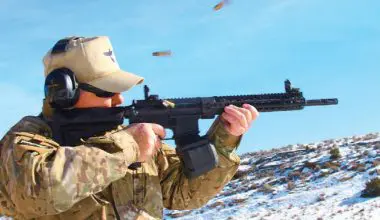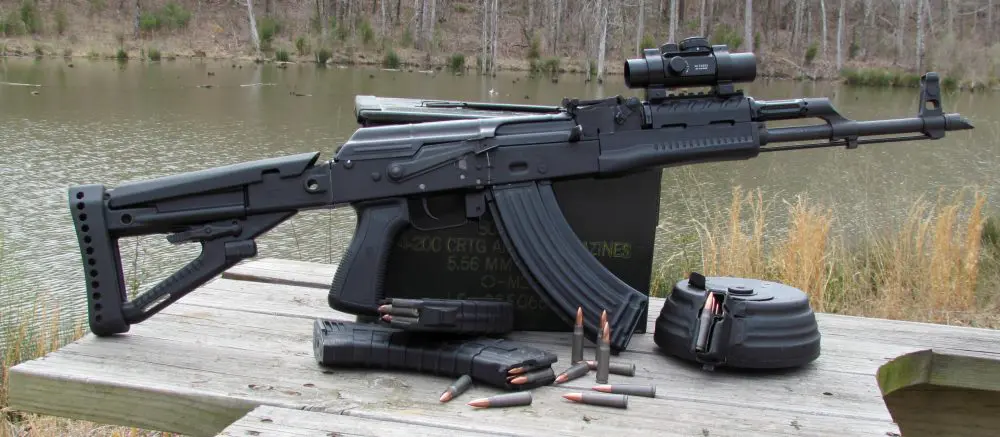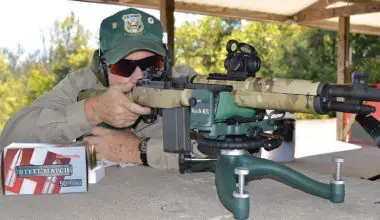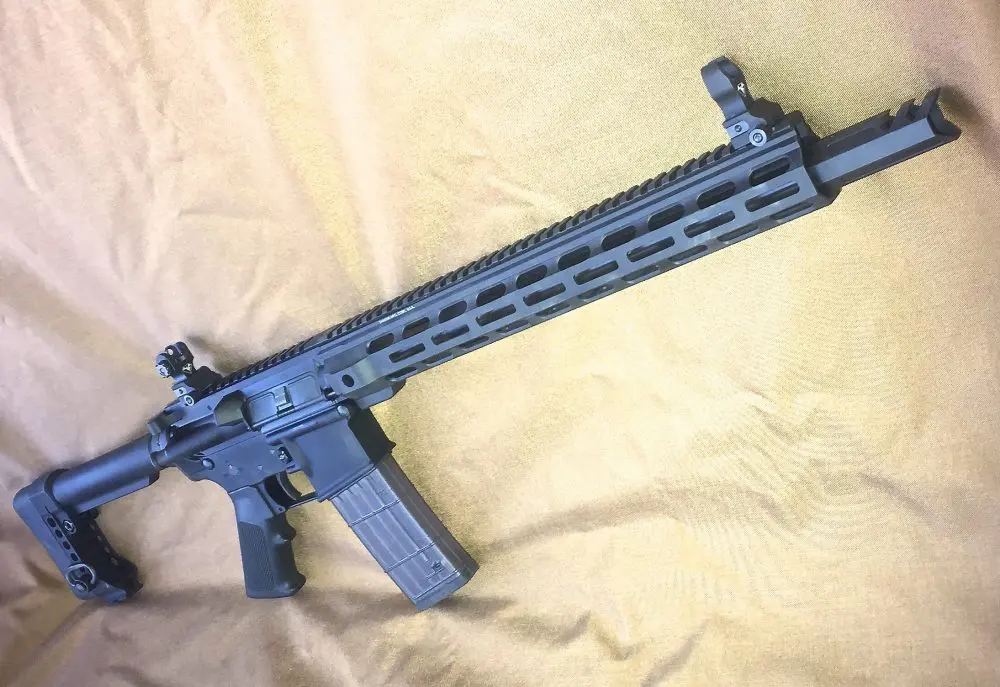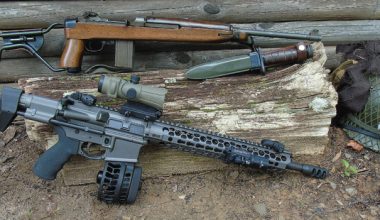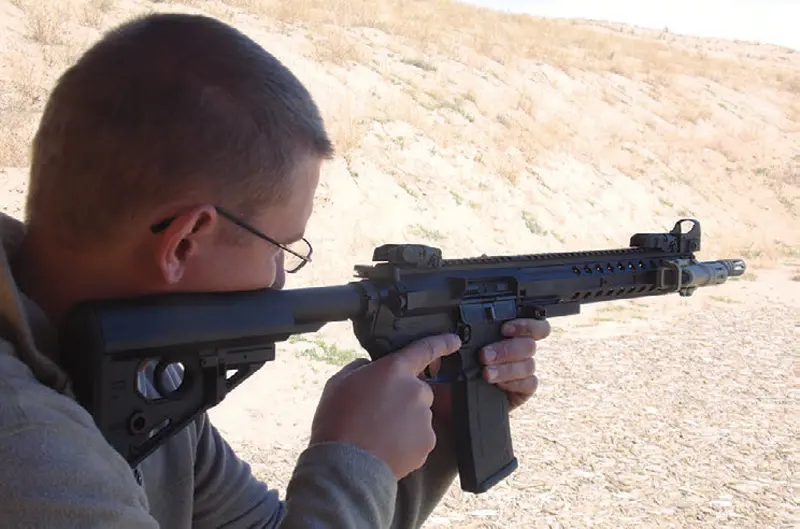
This was my first thought when I heard about the DRD Tactical takedown rifle, an AR-15 that can quickly and easily be taken down into two parts.
What’s the big deal about an AR-15 being in two parts? After all, the AR- 15 is manufactured as an upper half and a lower half, with the two halves held together when in use by two cross pins. That’s two parts right there. Other manufacturers make takedown rifles or components, and quick-change barrel systems do the same type of thing but inadvertently.
Why take down a rifle in the first place? At one time, only the military and SWAT would even have a remote reason to have such a weapon. Some DRD clients are police motorcycle officers. Dissembled into two parts, the DRD fits into a motorcycle’s saddlebags. In situations like active shooters, the first officer on scene—motor cop or not—is a first responder. With the DRD, they are tooled up like everyone else.
Short Barreled Rifles (SBR) are another option, but they are still highly regulated. Then there are citizens who wish to carry more than a handgun but need to stay low profile.
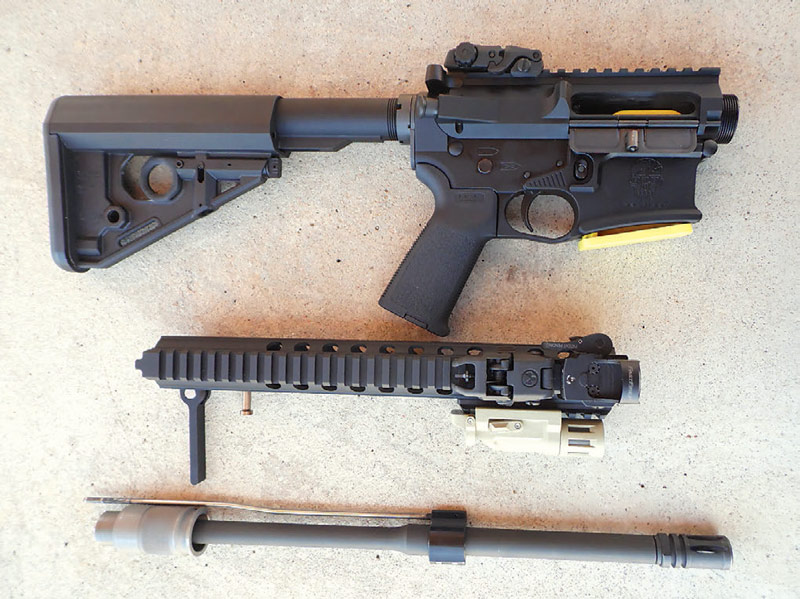
Table of Contents
THE RIFLE
The DRD Model CDR-15-223 is a fairly typical AR-15. It has a high quality 16- inch barrel. The stock as tested is the adjustable Tactical RAT from LaRue Tactical, which is a superior adjustable stock. DRD also uses components and magazines from Magpul.
The DRD lower receiver is enhanced with a trigger finger index pad—a raised gripping surface on the front of the magazine well and a curved shape to increase access to the magazine. The upper receiver is the flat-top style.
Like any AR-15, the DRD can be taken apart into two pieces by removing the two cross pins. In fact, to remove the bolt, you must take the rifle down this way. The other way to take down the DRD is to take the barrel and handguard off. This is where we get into the DRD takedown system.
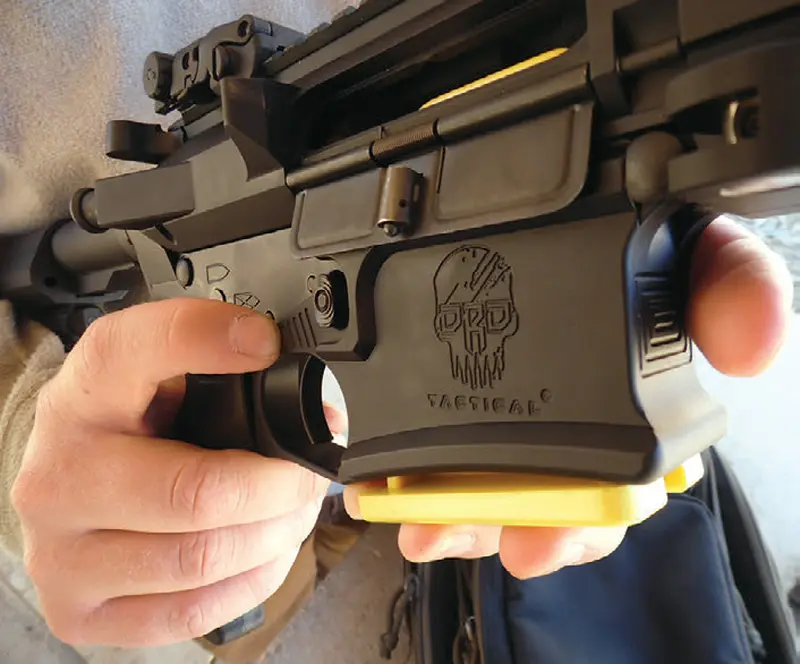
The barrel has the gas block and gas tube mounted in the normal fashion. Near the chamber end of the barrel is a thimble-shaped barrel nut. To assemble the DRD, draw back the bolt and lock it open. Align the barrel and gas tube with the upper receiver, insert and seat. Tighten the thimble by hand. At this point, the rifle can be loaded and fired. But DRD recommends that you add the handguard. The DRD handguard is a free-floating aluminum quad-rail style. Sections of Picatinny rail are provided so the owner can apply the rails only where he wants them.

The handguard slides over the barrel and will only go on one way. The handguard is against the upper receiver, a brass cross pin is pushed in and a lever folded over against the side of the handguard operates a cam that is very efficient at squeezing the handguard and locking it in place.
Although it’s not immediately obvious, when pushed in, the brass cross pin lies across the narrow portion of the thimble. This prevents the barrel nut from unscrewing itself. This is all pretty quick and efficient.
The difference in length between the DRD and a standard AR when taken down is about 17 inches instead of 24. Mechanically, so far, so good. It works, but does it work well?
PUTTING IT THROUGH ITS PACES
The forearm can be considered a part of the sighting system and it is of obvious concern when any part of the sighting system is disrupted. So this brings up the question of how accurately does the DRD system work?
I like John Farnam’s method to mount a mini red dot sight (MRDS) as close to the muzzle end as possible. The red dot is out there, quick to acquire, easy to see and does not block your vision.
I mounted a Bushnell Fast Fire MRDS on an American Defense QD base on the top rail all the way to the end of the handguard. I grabbed my favorite Black Hills Ammunition and headed to the range.
I zeroed the sight at 100 yards on the assembled rifle. I then disassembled it, reassembled it, shot the rifle for groups, and then repeated the process. Quick five-shot groups over the MRDS consistently yielded a roughly two-inch group. Accuracy of the DRD system seems to be consistent.
Considering that the DRD would be set up for a quick and dirty reaction, back-up iron sights (BUIS) were added for insurance. For more precise shooting, optics would be mounted on the upper receiver and be less affected by the movement of the handguard into and out of the receiver.

Mounting optics on the upper receiver would enlarge the overall footprint of the DRD rifle, so quick-release AR scope mounts from LaRue would be ideal for this. Just make sure you test this setup for zero until you are absolutely confident in the results.
ISSUES AND SOLUTIONS
The DRD comes in a high-impact plastic case sized to fit the rifle when broken down. Also available from DRD is Voodoo Tactical’s Discreet Carry Pack, a very rugged and practical bag. It looks good and would not be out of place in any situation. There are a couple of considerations for using it to carry the DRD. The barrel only fits longwise— and just barely—in the longest compartment, which is against the carrier’s back. The buttstock assembly fits in either the first or second long compartment. Also, with the two upper pieces assembled inside one another, the barrel rings the handguard like a bell. Not good for sound discipline.
Solution: Keep the two pieces separate until actually in use. This leads to an important backpack carry consideration. Carried in the pack, the rifle could be in for rough handling. The gas tube projects beyond the chamber end of the barrel, and it or the handguard could be bent, which could prevent the rifle from being reassembled.
My solution is a hard plastic cap that covers the gas tube end and protects it from impact. A retaining lanyard can also be attached to the pack so the cap pops off when the parts are removed. Padded sleeves would be a nice touch for parts carried in the same compartment. The pack has sufficient space to carry additional ammunition.

There are also two small hitches in making the process fast and efficient. First is that the bolt has to be open in order to insert the barrel. AR bolts are notorious for slamming shut if knocked or bumped. This sudden closing of the bolt could throw the process out of order. For ease, my solution was to lock the bolt open and insert a high-visibility magazine block. The block keeps the bolt in exactly the condition you want it in without undue interference to the next step of loading the weapon.

There is also a more practical/tactical method called the Chamber-View, a high-impact plastic insert that fits into the ejection port and blocks access to the chamber. It’s a reliable safety device, but even better for our purposes. Unlike the magazine block, a magazine can be inserted into the magazine well even with the Chamber-View in place. In this configuration, after the barrel is secured to the receiver, the block is pulled away and the bolt is free to strip and feed the first cartridge out of the magazine.
The second hitch is the brass cross pin. When disassembled into the three major parts and the cross pin pushed in, the handguard cannot fully slide over the barrel and barrel nut. It has to be manually withdrawn. But leaving the cross pin out requires the lever to also be left open. It’s not that big a deal, but there are now two new things to catch on during handling. I don’t have a ready fix for this, just knowledge of the situation and practice. Finally, the only other issue I had with this rifle was that the dust cover would not stay closed.
SUMMING UP
Here’s a question the DRD rifle may be a good answer to: “How do you carry a rifle in almost all circumstances—airline terminals, hotels lobbies, taxis— without drawing unwelcome attention?”
If the DRD rifle cost twice as much as a standard AR-15, I would pass on the DRD, buy a standard rifle and buy more ammunition with the savings. But the DRD is priced right in line with other quality AR-15s, so I’d be happy to buy and carry it.
